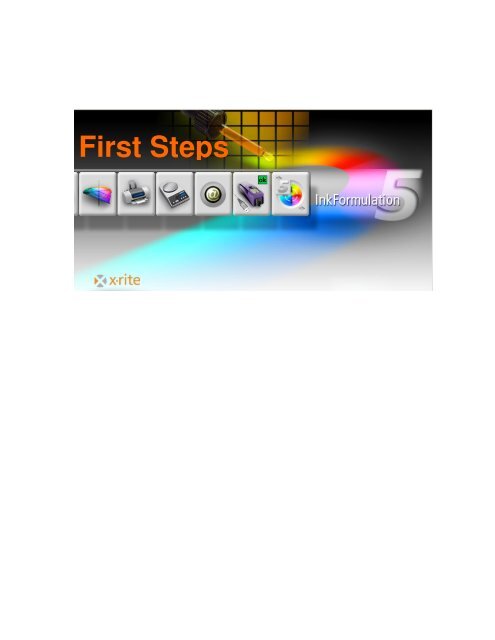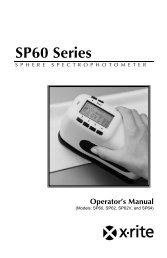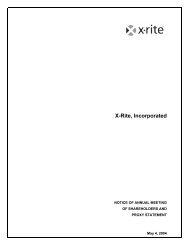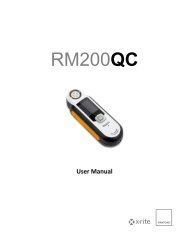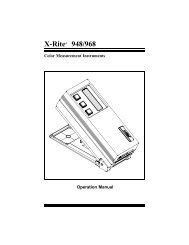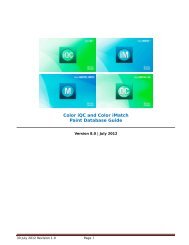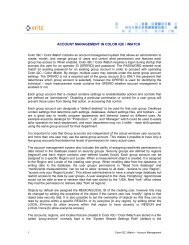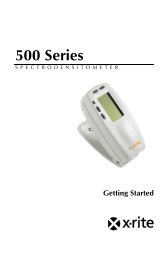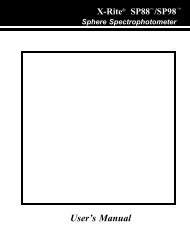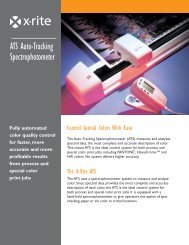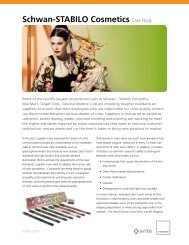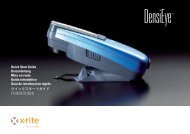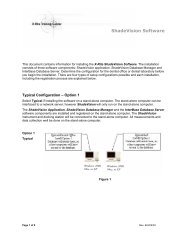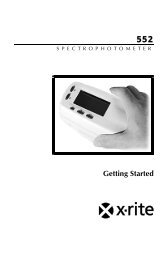InkFormulation 5 First Steps EN - X-Rite
InkFormulation 5 First Steps EN - X-Rite
InkFormulation 5 First Steps EN - X-Rite
Create successful ePaper yourself
Turn your PDF publications into a flip-book with our unique Google optimized e-Paper software.
Set measuring conditionsGeneral settings1. Menu settings → General2. Please adopt the stored measuring settings in the window “General Settings”3. Click “OK” to quitRemark: If you change the language you have to restart the <strong>InkFormulation</strong>6
Display of settings1. Menu: "Settings" > "Display"2. Please adopt the given settings in the window „Display of settings“3. Click „OK“ to quit7
Loading of assortment1. Click on the up-arrow on the left side of ”assortment”2. Please choose „Flexo/Gravure incl. colorant elements (Pol, Leneta)“ in the thenopening database and click on ”choose”.The name of the chosen assortment appears in the main window.Remark: The item „assortment“ characterizes a database which contains basic colors.8
Create a basic formula1. Click on the symbol ”formulate” → ”Basic formula“2. <strong>First</strong>ly the guideline color has to be defined. Instead of measuring the color you canload the color data via ”ColorNet“, ”Color Guide“ or „Lab entry“.ColorNet is the connection between the various X-<strong>Rite</strong>-Applications (<strong>InkFormulation</strong>,ColorQuality, Spectrophotometer). Saved colors can be exchanged via ColorNet.You can enter the color data with defined colorimetrical terms via the Lab-Entry.However this definition of the guideline color has the disadvantage that the<strong>InkFormulation</strong> doesn’t experience any remission data but only the calculated color data.Via “Color Guide” you can choose the Pantone coloring according to the substrate(coated, uncoated, matte) and the lighting conditions (this button assumes that the colorguide libraries are provided).9
Please load a saved color via ColorNet for the exercises:1. Mark the draft of „Table Brown“ in the index „<strong>InkFormulation</strong>“ → „Default“ →„Formulation“ → „Default“ → „Table Brown“.2. Click on „Choose“ to load the coloring as color draft.After double clicking the supreme folder „X-<strong>Rite</strong> ColorNet“ all available applicationsappear.Remark: The structure of the ColorNet is analog to the one of the Windows Explorers. By doubleclicking the folders the ones below will open. Should several folders not be visible, please doubleclick on the folder above of them.10
3. The next Step is to define the substrate type of the draft. For our exercise, pleasechoose “coated” and click „OK“.4. In the next step the substrate for our formulation will be announced. For our examplewe choose the option „Substrate of the current assortment“ and click „OK“.Remark: The substrate information is as important as the color to be formulated for theformulating as the program has to account (compensate) for the color of the substrate in theformulation calculation.11
5. As fourth Step we can change the thickness of the coating. We leave it on 100% andclick „OK“.100% meansRemark: This setting can be conducted in Menu „Settings“ → „Formulation“. There is a controlintegrated to the formulation procedure. The window is optional and may be deactivated in thesame menu.12
Now the window for the color option appears. The available basic colors of the currentlyloaded assortment („Flexo/gravure printing incl. Colorants elements“) are listed on theleft side of the window.6. Click on the double-arrow to bring all colors to the right side. Formulation can bedone with the colors of the right side. Click on „OK“.Remark: You are not forced to choose all colors, but you can also remove a part of the basiccolors to the right window (single colors can be chosen by double-click or by marking andactivating of the right-side arrow). Please note that that the program may be limited by a selectivechoice of basic colors in the formulation possibilities.13
7. Now the window of the formulation options appears. Deactivate the option „Showonly the best formula with 1, 2, 3 and 4 components“.8. In the field „assorted by“ click on the upwards-arrow. There you see the list of thepossible sort criteria. Choose „X-<strong>Rite</strong> Optimum“.Remark: The „X-<strong>Rite</strong> Optimum“ is a recommended combination of different criteria like Delta E,number of components, metamerism etc., and the criteria are listed by their importance.14
The formula appears only in the main window:You are not forced to use the first formula. Usually you can choose the second or thethird, because often there are only very few differences between the first three or fourformulas regarding the formula performance. Please use the ahead- / aback-arrow tochoose:15
9. Click on „Formula → Spectra“ in the toolbar. In the window that appears there aredrafts and formulas compared in different displays.Comparison of the remission curve:CIELab color circle:The red cross in the centre shows the draft, the blue cross shows the formula.16
Comparison of draft and formula on white and black for three different illuminants:This aspect gives you a visual impression of the color under three different illuminantswith adequate color distance dE (ie. D65, D50 and A).Display of the formula under different illumination techniques:Display of the behavior by changing the coat thickness:Remark: The position of the window is not fixed. You can remove it while keeping the left mousebutton pressed on the blue bar on the upper side of the window. By pulling one edge of thewindow while keeping the mouse button pressed, the size can be adjusted (bigger or smaller)17
Saving of the color formula:10. In the toolbar, click on „Formula → Save“.11. Put in the name “brown” as formula name into the window and save the formula byclicking „OK“.Herewith the formulating procedure is finalized and the formula saved. It can be printedand mixed now.18
Create a correction1. Please load the earlier saved formula „brown“. Click therefore on the symbol„Formula → load“.2. In the appearing window please double-click on “brown” or mark it and click on“choose”.Remark: In the <strong>InkFormulation</strong> you basically have two possibilities to choose a color: either bymarking a color and clicking on „choose“, or by double-clicking on the corresponding formula.19
After loading the formula please click on the symbol „Formulating → adjustmentformula“. In the appearing color selection window the colors of the formula are alreadypreselected.3. Click on „OK“.Remark: It’s mostly beneficial to realize an adjustment calculation with colors which are alreadycontained in the formula. Should the adjustment result not be satisfactory, you can realize anadjustment calculation with all colors.20
4. In the next step you have to enter the current mixture. In practice it’s normallyrealized by measuring the mixed and printed basic formula. In our exercise we takethis color via ColorNet. For this, please click on „ColorNet“.5. Mark the color „Formula: calculated“ in the ColorNet in „<strong>InkFormulation</strong>” → „Default“→ „Formulas“ → „Table Brown“. Click „Choose“21
6. After the calculation the window „formula choice“ appears. Click on the downwardsarrowto open the formula list. As we can see, there was only one adjustmentcalculated.7. Click on „OK“ to adopt the adjustment.22
The adjustment of the formula is shown well-arranged:8. By activating „Total color quantity“ the color quantity becomes editable. Reduce thecolor quantity to 100 by actuating the upwards-arrow and click on „OK“.Remark: You can see on the result of the adjustment that in this case there was no improvementof the formula possible anymore. This is not important for our exercise though.23
In the main window you can see the adjustment quantities in the second row on the rightside next to the original quantities.The addition of the basic- and adjustment quantity is realized via „ Add to additional inkquantity “. This can be done in two different ways:a) Menu „Formula“ → „ Add to additional ink quantity “ orb) By actuating the right mouse button in between the formula window, whereby apopup-window will be opened where you can choose the instruction „ Add toadditional ink quantity “:9. Click on „Add to additional ink quantity“.Remark: Besides the instruction „ Add to additional ink quantity “ you can complete severalactions more in the popup-window.24
After adding the adjustment the total of the color quantity is 100 again, like we had set inthe window „Formula Adjustment“ earlier.Remark: Basically there are 2 possibilities to realize an adjustment:a) The color will be mixed again with the adjustment quantity. In this case you have tochoose above procedureorb) You change an already existing mixture. In this case the formula will be printed with theseparately indicated adjustment quantities.In this case you have to choose the option „Existing color quantity“ instead of „Totalcolor quantity“ in the window „Adjustment of the formula“ and you have to reduce thequantity by the quantity which was already used for the proof.Example: Mixture: 100g; Consumption of proof: 15g; → „Existing color quantity“: 85g.25
10. Save the adjusted formula by clicking the symbol „Formula → Save“.11. Keep the formula name „Brown“ in the appearing window and click on „OK“.12. A warning signal shows up with the information that this name is already in use.Confirm with „Yes“. So the original formula will be replaced by the adjustmentformula.26
Create an ink leftover1. Menu „Database“ → „Ink leftovers2. Click in the window „ Define ink leftover “ → „New“27
3. In the third step you will be asked to define the ink leftover:In practice there would be measured only a printed ink leftover. Instead of that we loadan existing color via ColorNet.4. Click on „ColorNet“ and mark the draft „Brown“ in „<strong>InkFormulation</strong>“ → „Default“ →„Formulas“ → „Default“ → „Brown“ → „Choose“:28
5. Please define the substrate in the next step. Choose „Substrate of the currentassortment“ and click on „OK“.Remark: In the practice the substrate would normally be measured, because usually it differsfrom the assortment substrate. For the <strong>InkFormulation</strong> it is very important to obtain the exactsubstrate information. So the substrate color can be correctly compensated.29
6. Please enter „Ink leftover brown“ into the window „Prepare color“.7. In the field „Available quantity“, please enter „25“ and „kg“ as unit.8. The ink leftover is now saved on the database. Quit the process by clicking “Close”.Remark: This process to enter the ink leftover is not the only one. Further information provide theonline help or the user’s manual.30
Formulate with an ink leftoverWe recalculate the formula „Brown“ by involving the just defined ink leftover. <strong>First</strong> of all,load the saved formula “Brown” (Menu → „Formula“ → „Load“).1. Activate the control box „Use of ink leftover yes/no” below on the left side of the mainwindow.2. Menu → „Formulate“ „Recalculate“Remark: „Recalculate“ can always be used if the draft color and the substrate keep beingunmodified and only the formulating process should be realized again.3. In the window „Entry of color quantity“ please activate the control field „Restrict inkleftover“. Click on „OK“.31
4. In the next step you see the window „Choice of color“. On the right side of thewindow the basic colors of the formula as well as the ink leftover „brown“ are alreadyselected. To add the remaining assortment colors please click on the right-showingdouble-arrow.Remark: The area [0%...25%] ink leftover indicates that the part of the ink leftover of the existentquantity move between 0% and 25%. The ideal quantity per calculated formula will be establishedby the program.5. Click on „OK“ to start the formulating process.Remark: You could have formulated also only with the previous colors plus the ink leftover. Sincewe provided all colors the system received a maximum of possibilities.32
6. In the window „Color choice“ please click on the downwards-arrow. As you can seein this case there were only 4 formulas calculated.7. Click on „OK“ to adopt the formula.Remark: By activating the utilization of the ink leftovers the <strong>InkFormulation</strong> is forced to use atleast one ink leftover for the formula.As consequence an undefined number of calculated formulas can follow as it depends on howgood the ink leftover matches to the current color draftAre several ink leftovers available, the <strong>InkFormulation</strong> automatically chooses the best-matchingink leftover33
We see that the maximum quantity of the ink leftover was attached. This is because thisbrown matches well to the brown color draft.8. The use of the ink leftover of the <strong>InkFormulation</strong> contains a semi-automatic quantitymaintenance. This means that the used quantity have to be charged manually afterformulating. This happens as following:Menu: „Formula“ → „“Reduce ink leftover“.9. In the window „Reduce ink leftover“ the state before and after the charge of the usedquantity in the formula is showed. Click on “OK” to realize the charge.10. Please save the formula as following:Menu → „Formula“ → „Save“. Please enter as name „Brown with ink leftover“ andclick on „OK“:34
11. Reopen the window of the ink leftover database (Menu: „Database“ → „Inkleftovers“). Here we can see that the original stock of „25“ was reduced by the usedquantity in the formula and has now a new stock of „0“.Remark: To work with the quantity is not mandatory but an option. You can work without quantitywithout any problems. The user has to control by himself that the ink leftovers (which are used inthe formula) are available in the required quantity.12. Hereby the formulating circle under use of an ink leftover is finalized. Please clickon “Close”.35
Enter a formula by handThis function enables the creation of existing formulas into the <strong>InkFormulation</strong>.1. Menu: Formula → „New“.2. In practice only the proof of the formula would be measured. In our example weload the color via ColorNet. Click in the window „Entry of Formula“ on „ColorNet“.Remark: The case which we are regarding is based on existing proof resp. dross.If only the formula is available, you can enter it via Menu „Formula“ → „New“ → „Calculate“. Thecolor of the formula will be then calculated by the <strong>InkFormulation</strong>.36
3. By double-clicking the window „ColorNet“ on the concentration stage of 55% ofthe assortment color „Orange“ in „<strong>InkFormulation</strong>“ → „Default“ → „Assortments“→ „Flexo/gravure printing incl. Colorant elements (Pol, Leneta)“. This would beour mixed color.4. For our example please choose the substrate of the current assortment. Click on„OK“.Remark: In practice it is very important to measure the original substrate on which the formulawas printed.37
In the window „Entry of the formula“ above on the right side the color shade appears withthe corresponding color data under “Formula measured”.5. Entitle the color „Formula Orange“.6. In the left window please double-click with the available assortment colors on„Orange“.7. Enter the quantity “55” into the field „Color quantity“.8. By double-clicking on „Transparent white“ in the left window with the assortmentcolors the transparent white changes as well to the right side of the formulawindow.9. Please enter the quantity „45“ into the field of the color quantity.10. The formula is now completely composed. Please click on „OK“.38
The formula appears in the main window.39
Create a new formula folderWe save the just created formula in a new formula folder. Therefore we have to create afolder first:1. Click on the symbol „Formula → Save“ (Symbol disk) or choose the option overMenu „Formula → Save“.2. In the window „Save color formula“ click on „Change folder“3. In the window „Choose current folder“ please click on „New“.4. Entitle the new folder with „Test formula folder“ and click on „OK“:40
5. Mark the „Test formula folder“ in the window „Choose current folder“ and click on„Choose“.6. Over the button „OK“ the formula will be saved in the chosen folder.41
Search a formula: by nameThis research helps to find formulas again.1. Click on the symbol „Formula → Load“. The window “Database” appears.2. We are searching our first created formula „Brown“. Therefore click on „Search“.3. In the window „Search criterion“ under „Name“ please enter „Brown“ and click on„OK“.Remark: To refine the search you can enter the specific date or period.42
4. The window stays empty, no formula found. To change the folder please click onthe button “Folder” below on the left side or change the folder via the selected listabove on the right side.5. Mark the folder „Default“.6. Now you can see 2 colors with the character „Brown“.Remark: All formulas which contain the searching criteria as character are shown.7. We close the window without choosing the color „Brown“. Click on “Cancel”.43
Search a formula: by smallest dE*This kind of searching is used before formulating to find formulas which are similar to theformula you want to create.1. Menu: Formula → „Define draft“ → „Load“.2. Now the color draft has to be measured. For our exercise it is sufficient to load areference of the ColorNet. Click on „ColorNet“.3. To simplify matters we define the 55%-level again as draft from “Orange” to“<strong>InkFormulation</strong>” → „Default“ → „Assortments“ → „Flexo/gravure printing inclcolorants elements (Pol, Leneta).4. Mark the color and click on „Choose“ or double-click on the 55%-level.5. In the next step you see the window „Choice of color“. You can limit the choice tofilter formulas with unwished color components. Click on the right-side doublearrow.44
6. The program now changes to the formula database and lists all existing formulas.In this list is chromatically arranged and begins with the color with the smallestcolor distance (smallest dE*).The indicated formula corresponds with our draft. The program accordinglycalculates a dE* Gretag of 0,0.45
7. Click on the button „Search“ and in the window „Show formulas of followingfolder“ on „All Folders“.8. The search criteria were expanded for the program. Therefore there are severalformulas shown (of all folders):Remark: As you can see in the window „Search criteria“ there is the possibility to limit / expandthe search to:- Formulas of the current folder- Formulas of all folders of the current assortment / of all assortments- Formulas only with contained color (limited to one assortment)- Substrate-related formulas- Only formulas of ink leftovers and base formulas46
Create a substrateIf you often use a constant substrate you have the option to save it in the database.Instead of measuring the substrate for each formulating process you can load it from thedatabase for the formulation.1. Menu „Database → „Substrate“2. In the window „Database: Substrate“ click on „New“:3. Please enter „Own substrate“ as name.Besides the name of the substrate you can indicate the type and the quality of thesubstrate as well as give information about the surface finish (only on uncoatedsubstrates).47
4. Choose the option “coated” for the „Quality of the substrate“5. In practice you would measure the substrate. For our exercise we load thesubstrate of „ColorNet“. Click on „ColorNet“.6. For the measurement of the substrate please double-click on „<strong>InkFormulation</strong>“ →„Default“ → „Assortments“ → „Flexo/gravure printing incl. colorants elements(D65, Leneta).7. Choose „Substrate on white“ and add it via „OK“ to „Own substrate“. Repeat thisprocess for the measurement of substrate on black.48
8. Finalize the entry for the substrate by clicking on „OK“.The new substrate appears in a list together with the remaining substrates. By closingthe window the measurement of the substrate is finished.Should the substrate information be adopted of the database for future formulas you canclick on the option „Substrate on the database“ and arrive directly to the database of thesubstrate.Remark: The presented possibilities are very comfortable and always guarantee the exactidentical substrate values. There is no influence exerted on eventual substrate variations though.If the quality varies the substrate to be printed should be measured each time. Otherwise therecan already be incorrect information for the formulation.49
Back-up a database1. Menu: „File“ → „Database“ → „Save“2. To simplify matters we safe the backup on the desktop. Keep the name„dbif.ifbx“.3. Click on „Save“. All data (Formulas, assortments, substrates, etc) have a back-upin only one file.Remark: As a matter of course the name of the backup can be change according to the userrequirement.For security reasons the backups should be saved on an external medium or on a network drivewhich gets a regular back-up itself as well. The backups should be created on a regular basis, i.e.weekly.50
Restore a database1. Menu „File“ → „Database“ → „Restore“.2. Mark the just saved backup „dbif.ifbx“ and click on „Open“.3. In the window „Restore database“ please choose the option „Overwrite DB“. Confirmthe now appearing warning signal with „OK“.Remark: Attention with the option „Overwrite DB“. You should only choose this when you reallywant to overwrite (replace) the existing database.With the option „Amend DB“ new data (since the last backup) will be added to the existing data.The existing data will not be changed.End of exercise.On the next page you’ll find an overview about general settings.51
Settings: General1. Menu: → „Settings“ → „General“a. Standard measuring conditions: normally analog like the display belowwhereas under the file „Filter“ there has to be taken a choice only bycreating a new assortment. Apart from that the program requiresautomatically the filter with which the current loaded assortment wascreated.b. Color system: Here you can always switch between „CIE-Lab“ and „CIE-LCh“. The values are shown accordingly in the main window.c. Illuminant for metamerism: With above mentioned settings possiblemetamerism is shown under „warm“ (yellowish, „A“) and „cold“ (bluishwith parts of UV, F11) light. This is a usual setting.d. Averaging: for homogen color films one measurement may be sufficient. Ifthe color film is broken or turbulent we recommend 2, 3 or moremeasurements.2. Click on „Cancel“ to close the window.52
Settings: Formulation1. Menu: „Settings“ → „Formulation“a. Adjustment of the formula: In „Addition-Mode“ the adjustment quantitiesare shown as second row in the main menu. In „Basic formula-Mode“ theadjustment quantities are immediately added to the quantity of the basicformula..b. Formula edition: The available options depend on the printing processand the installed modules. Following are possible: „Printable colors“,„Master colors and dissolvent“ and „Basic material“.c. Control of the coverage: „no (only color optimization)“ is the usually usedsetting. Are colors with partial or complete coverage available and wasthe assortment threaded in by white and black there could be fixed aspecific draft regarding the coverage on the basis of another setting.d. Coat thickness (Coloring calibration = 100%): If there is a difference of thecoat thickness between the coloring calibration and the printing processthere could be done a general adjustment by an adaption of thepercentage values.e. Furthermore the user has the option to turn off several steps of theformulation. You can i.e. deactivate the window „Choice of color“.2. Close the window with “Cancel“.53
Settings: Display1. Menu: „Settings“ → „Display“a. Formula edition: „Fix number of decimal“: The number of the digits afterthe comma which are shown in the main window and on the printedformula can be defined. „Maximum color distance“: borderline until wherethe formulas are shown.b. Database: If this option is activated only formulas of the current loadedassortment are shown in the formula database.c. Tolerance: With this setting the dE*-Tolerance borderline can be fixed. Inthe display of the color space this borderline is shown as a gray circle.d. dE*-Formula: For the identification of the used Delta E*-Formula.2. Close the window with “Cancel“.54
Settings Batching systems1. Menu: „Settings“ → „Batching system“In this window you can define the connection to the dosing arrangement.2. In the column „Available dosing systems“ please choose „Universal BatchingSystem“ and click on the right-showing arrow.3. Mark the system and click on „Edit“.55
4. In this window you can fix the formula edition and the order of the dosing.5. Click on „Setup“. Indicate the initial path for the formulas to be dosed.6. To leave this setting please click on „Cancel“.56
Settings: SPM1. Menu: „Settings“ → „SPM“In this window you can search and calibrate a connected spectrophotometer.Furthermore you can choose the serial interface (COM) and eventually set the baudrate. On the down side of the window you’ll find information about the connecteddevice (Serial number, software version).2. Please leave the window with „Close“.Remark: Besides X-<strong>Rite</strong> measuring devices some devices of competitors are supported as well.These are listed in the window for the choice of devices.57


